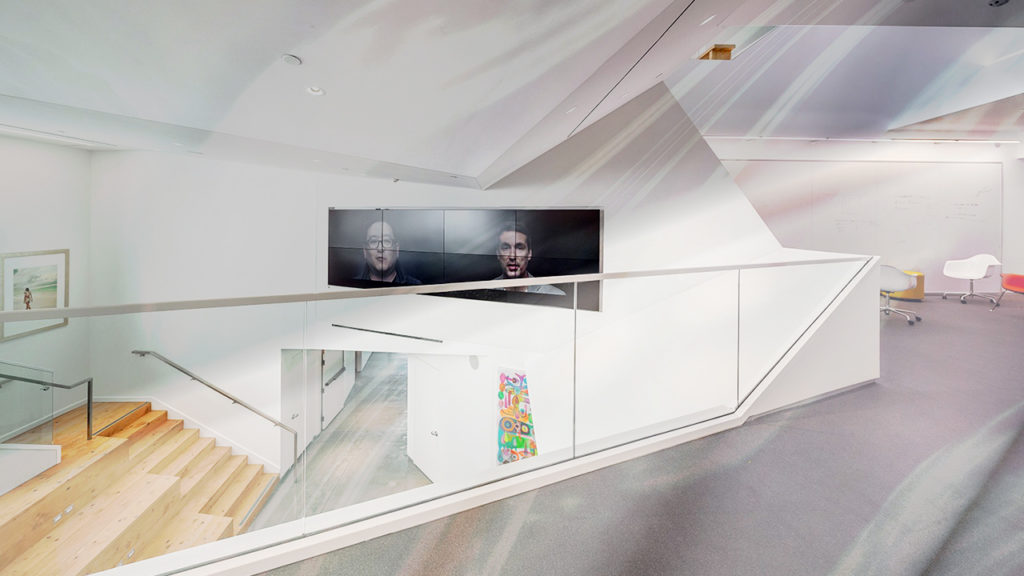As a.network approaches its one-year anniversary of working remotely, it’s been my mission as chief financial officer to help reimagine our workplace and create a future-forward model that aligns with the disruptions the industry has faced. Though it’s difficult to predict anything without a clairvoyant ball, I’m humoring myself with a vision that involves the concept of community shifting dramatically. In the fashion of Steve Jobs, I’m trusting that the dots will somehow connect in a.network’s future.
Rather than taking a wait-and-see approach to establishing new policies, we’ve hit the ground running on an idea that embraces the phaseout of physical spaces and the potential to build in-office company culture remotely. As part of our network growth, over the next two years I see this evolving into a hybrid community where complementary companies can congregate—in person and digitally—and new intellectual properties are born.
Our nearly 250 employees have yet to return to Ayzenberg headquarters in Pasadena, California. Essential functions such as the finance team go in as needed and our creative teams have access to the studio. Since shifting to virtual work, our staff has displayed impressive resilience and adaptability in the way they listen, create and share both internally and with clients. It’s become clear that this set-up is not only effective but that most of our members actually prefer it. Echoing this sentiment is data from a global Slack survey in October 2020, which revealed that 72 percent of workers would prefer a mix of both in-person and remote work.
A professional from Google got a clue as to what that hybrid model might look like down the road when they asked the Blind platform to share their optimal hybrid environment. The consensus: 43 percent of respondents desire a week in which they work three days remotely and two days in the office.
Many employees worldwide have grown accustomed to splitting their time between the office and Zoom screens. But agencies and brands must quickly figure out how to reinvent their space to make it conducive to innovation. The way I see this manifesting is a.network orchestrating partnerships with other like-minded companies, entrepreneurs and even freelancers that can add value to each other. These partnerships will take place both in physical spaces that we currently operation and will expand into digital ecosystems.
Our hope is that the partnerships we forge would become fully integrated within the dual physical-digital a.network ecosystem, a hub of innovation that might feature digital war rooms in addition to an event space where product demos, public lectures and IP testing occur. Participants would gain access to the cutting-edge technologies and systems a.network has built and perfected over the past 25 years. This would produce more opportunities, more leverage and in turn, greater value for all parties.
The idea of creating a community around space is not new, but it would behoove brands to take a collaborative approach at a time when consumer behavior is rapidly changing and budgets are being shifted or slashed. The fourth annual 2021 Creative Management Report by inMotionNow and InSource found that while in-house creative teams still oversee most of the work, 86 percent reported that they currently partner with agencies and freelancers. What’s more, in 2021, nearly one-third of teams are planning to increase the work they send to outside resources.
The hybrid model could extend to larger companies as well. For example, if a.network joined forces with an equally reputable agency, the possibilities for growth would be limitless. Want to assemble a best-in-class production team? We’ve already done that. Need an entirely new finance system? We’ve built one. It’s about having access to capabilities and being able to deliver a higher, better product for all of our collective clients.
Together the different disciplines and companies would work to understand what services they could sell for each other and where there’s talent overlap. Both would be able to apply learnings from interactive approaches, retain talent and access exclusive programming. The financial implications would be decreased cost of labor and infrastructure. Personally and professionally, it would enable greater development.
There will be challenges to implementing this digital-physical workforce model that I propose, starting with humanizing it all. In the last 12 months, millions of workers have felt the effects of Zoom fatigue, burnout and feelings of isolation. Sure, we’ve gotten the hang of how to balance work while our kids are screaming in the back. But for a hybrid environment to succeed, companies must prioritize connections and refresh employee engagement tactics. This work should be rooted in personal interactions and relationships. Additionally, as with every innovative idea, we must take things slow and steady. This model needs to be planned out properly for us to actually launch it successfully and scale it sustainably.


